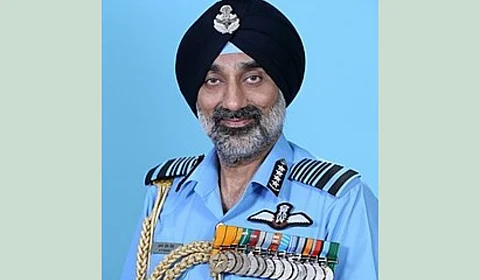

Air Chief Marshal Amar Preet Singh on Saturday, August 9, confirmed that the Indian Air Force (IAF) shot down six Pakistani aircraft during Operation Sindoor, including five fighter jets and a high-value surveillance platform, likely an AWACS (Airborne Warning and Control System) aircraft.
Speaking at the Air Chief Marshal LM Katre Memorial Lecture in Bengaluru, the Air Chief Amar Preet shared satellite imagery and intelligence inputs that chronicled the damage inflicted on Pakistan’s air fleet and terror infrastructure.
“These are the before and after images of the damage we caused at Bahawalpur, the JeM (Jaish-e-Mohammed) headquarters. There’s hardly any collateral here -- the adjacent buildings are fairly intact,” he said, pointing to high-resolution visuals that corroborated the precision of the strikes.
Operation Sindoor, launched on May 7, was the Bharatiya Janata Party (BJP) led Union government’s response to the Pahalgam terror attack that claimed 26 innocent lives in April.
“We have five confirmed kills and one large aircraft, which could be either an ELINT aircraft or an AEW &C aircraft, which was taken on at a distance of about 300 km. This is, actually, the largest ever recorded surface-to-air kill that we can talk about,” the Air Force chief said.
The operation targeted nine terror camps across Pakistan and Pakistan-Occupied Kashmir (PoK), eliminating over a hundred militants, according to defence sources. The offensive was executed with a blend of air-launched cruise missiles, electronic warfare assets, and real-time surveillance, ensuring minimal civilian harm while delivering maximum strategic impact.
“Our air defence system has done a wonderful job. The S-400 system, which we had recently bought, has been a game-changer. The range of that system has really kept their aircraft away from their weapons, like those long-range glide bombs that they have. They have not been able to use any one of those because they have not been able to penetrate the system.” the IAF chief said.
The Russian-origin S-400 air defence system played a pivotal role in neutralising airborne threats during the operation. The system was credited with the aerial kills, including the downing of the AWACS aircraft, which posed a significant intelligence and coordination threat to Indian forces.
The IAF’s strikes were not limited to aerial engagements. Ground targets, including key Pakistani airbases such as Bholari and Rahim Yar Khan, were hit with precision munitions. Intelligence inputs from satellite imagery, local media, and electronic intercepts enabled the IAF to verify the destruction of terror infrastructure and military assets.
“This was not just about retaliation -- it was about precision, professionalism, and purpose” the Air Chief Marshal concluded.